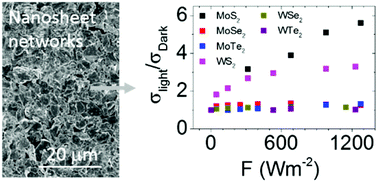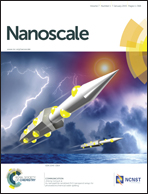Large variations in both dark- and photoconductivity in nanosheet networks as nanomaterial is varied from MoS2 to WTe2†
Abstract
We have used solution processing techniques to fabricate thin-film networks of nanosheets of six different transition metal dichalcogenides; MoS2, MoSe2, MoTe2, WS2, WSe2 and WTe2. We have measured both the dark conductivity and the photoconductivity under broad band illumination in the intensity range from 0–1500 W m−2. The dark conductivity varied from ∼10−6 S m−1 for MoS2 to ∼1 S m−1 for WTe2, with an apparent exponential dependence on bandgap. All materials studied show photocurrents which rise slowly with time and depend sub-linearly on light intensity, both hallmarks of trap limited processes. Because the photoresponse depends relatively weakly on bandgap, the ratio of photo- to dark conductivity is largest for the sulphides because of their lower dark conductivities. As such, MoS2 and WS2 may be best suited to photo-detection applications. However, due to their lower bandgap and superior conductivity, WSe2 and WTe2 might prove more effective in other applications, for example in photovoltaic cells.


 Please wait while we load your content...
Please wait while we load your content...